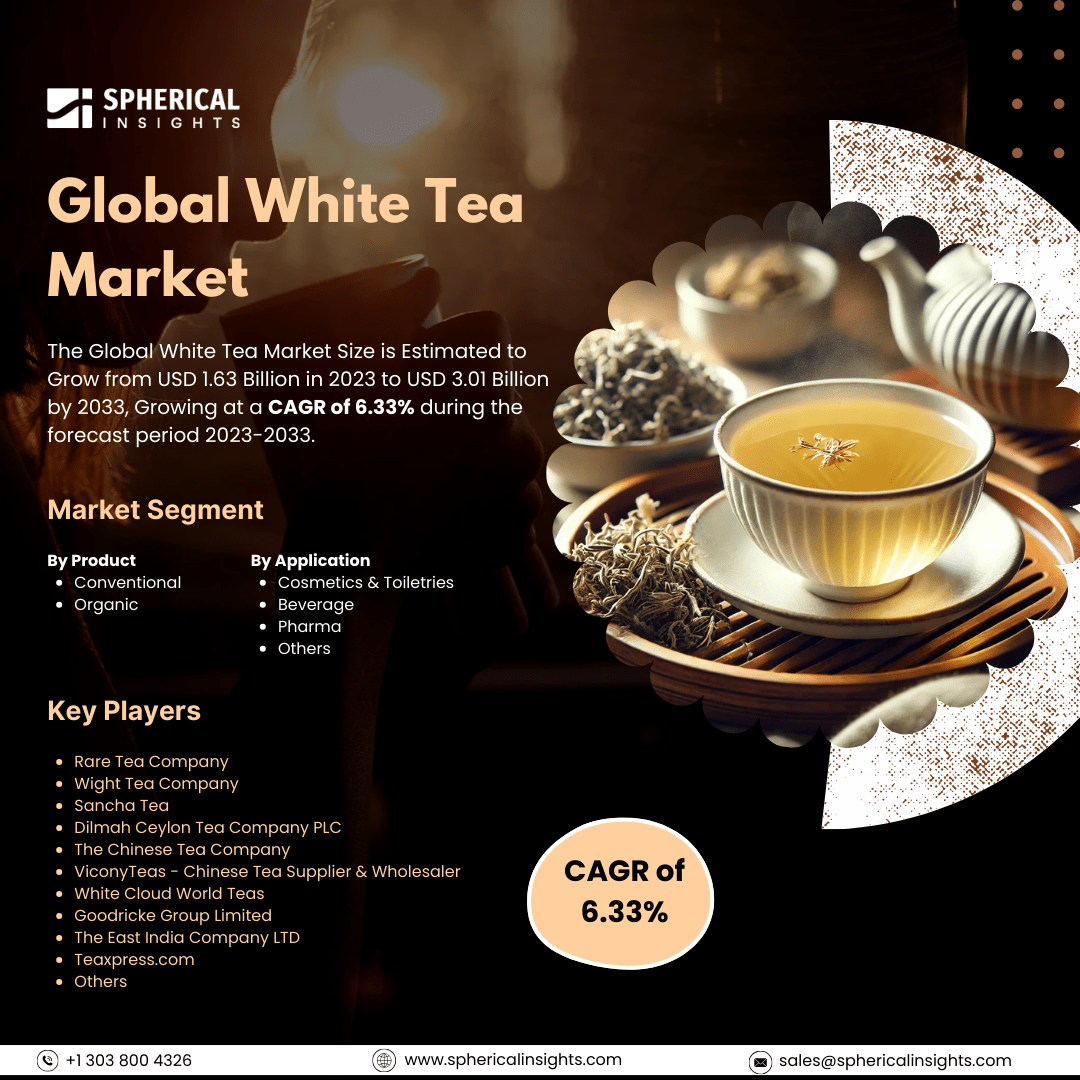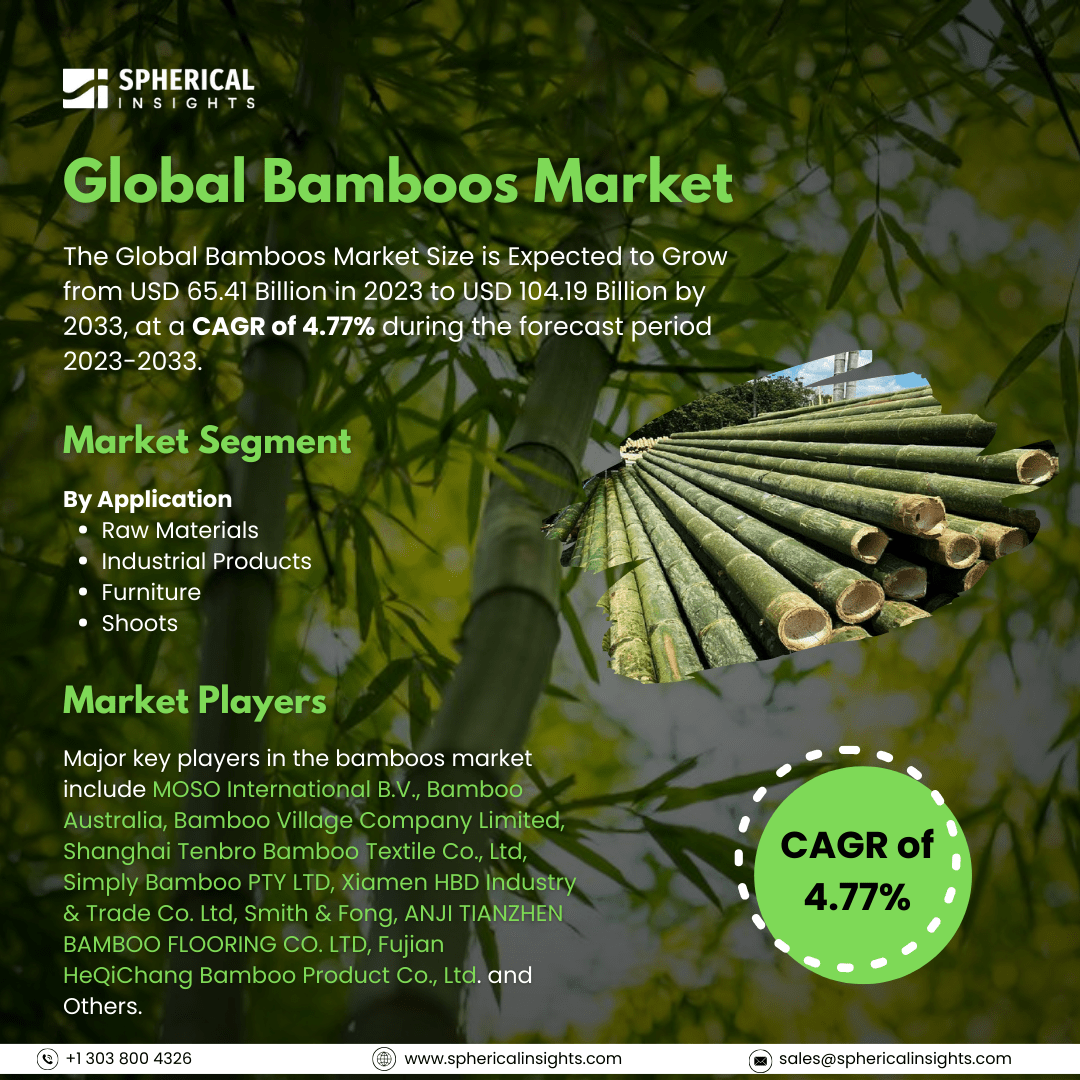Global White Tea Market Size to Worth USD 3.01 Billion by 2033
According to a research report published by Spherical Insights & Consulting, The Global White Tea Market Size is Estimated to Grow from USD 1.63 Billion in 2023 to USD 3.01 Billion by 2033, Growing at a CAGR of 6.33%during the forecast period 2023-2033.
Browse key industry insights spread across 215 pages with 110 Market data tables and figures & charts from the report on the Global White Tea Market Size, Share, and COVID-19 Impact Analysis, By Product (Conventional and Organic), By Application (Cosmetics & Toiletries, Beverages, Pharma, and Others), By Distribution Channel (Online and Offline), and By Region (North America, Europe, Asia-Pacific, Latin America, Middle East, and Africa), Analysis and Forecast 2023 – 2033.
White tea is a pale-yellow tea that gets its name from the whitish appearance of the tea plant's unopened buds. Its antibacterial and antioxidant qualities, which strengthen the immune system, are responsible for the market expansion. White tea helps lower the prevalence of oral bacteria and cardiovascular disorders. As a result, the pharmaceutical sector also uses it. White tea requires less time and effort to process because it is the least processed tea and is simple to prepare. Organic white tea has also gained popularity because of its environmental conscience, health benefits, and cleanliness. The market for organic white tea is expanding owing to a lucrative market niche created by consumers' shifting inclinations toward buying organic goods. The factors driving the market's growth are the increasing globalization and the expanding impact of many cultures. As consumers are exposed to a wider variety of cultures, cuisines, and beverages, they are becoming more willing to try new flavors. The consumption of unusual and unusual products, including white tea, has increased as a result. However, the high price of white tea in comparison to other types of tea and anticipated price changes for raw materials could hinder the market expansion for white tea.
The conventional segment accounted for the largest market share of 85.56% in 2023 and is expected to grow at a significant CAGR during the forecast period.
Based on the product, the white tea market is categorized into conventional and organic. Among these, the conventional segment accounted for the largest market share of 85.56% in 2023 and is expected to grow at a significant CAGR during the forecast period. Several flowery and fruity scents, including grassy, melon, peach, vanilla, apricot, honey, herbs, citrus, and chocolate, are offered in these reasonably priced products. Additionally, the conventional product category is anticipated to be driven during the projection period by the straightforward accessibility and affordable costs of the products offered through a variety of offline channels, such as supermarkets and grocery shops.
The beverages segment accounted for the largest market share of the white tea market in 2023 and is expected to grow at a CAGR of 5.85% during the forecast period.
Based on the application, the white tea market is classified into cosmetics & toiletries, beverages, pharma, and others. Among these, the beverages segment accounted for the largest market share of the white tea market in 2023 and is expected to grow at a CAGR of 5.85% during the forecast period. Worldwide, tea is a popular beverage. White tea is especially notable for its distinct twist, delicate flavor, mild taste, and potential health benefits. In addition, it takes advantage of the growing consumer interest in wellness and health, which feeds the demand for natural and minimally processed beverages. To satisfy the needs of consumers who prefer high-end and health-conscious beverages, producers have expanded their selection of white tea beverages to include iced teas, flavored blends, and ready-to-drink beverages.
The offline segment accounted for the highest market share of the white tea market in 2023 and is expected to grow at a CAGR of 6.01% during the forecast period.
Based on the distribution channel, the white tea market is divided into online and offline. Among these, the offline segment accounted for the highest market share of the white tea market in 2023 and is expected to grow at a CAGR of 6.01% during the forecast period. High foot traffic and broad reach, which serve a variety of manufacturers and consumers, are some of the reasons behind this. White tea products are easier to locate and purchase due to easy access, which expands the product's market. Several products and brands are often available through offline distribution channels. A streamlined distribution strategy is also offered by offline channels such as supermarkets and retail stores, which allows them to effectively reach a large audience without establishing several alliances with small businesses.
Europe is expected to hold the largest share of the white tea market through the forecast period.
Europe is expected to hold the largest share of the white tea market through the forecast period. In industrialized nations such as the U.K. and Germany, consumers' growing awareness of personal grooming and health issues is anticipated to propel market expansion. Additionally, the area has a large consumer base with strong purchasing power who are more likely to invest in high-end goods. The broad appeal of tea culture and the presence of well-known tea brands and merchants in Europe also contribute to the market's expansion.
Asia Pacific is predicted to grow at the fastest CAGR of the white tea market over the forecast period. A strong market base is established by the region's rich cultural heritage and long-standing tea-drinking tradition. Originating in Asia, white tea holds cultural significance and is deeply embedded in traditional tea traditions. Additionally, consumers in countries such as China and Japan are becoming more health conscious, which is driving up demand for natural and antioxidant-rich beverages.
Major key players in the white tea market include Rare Tea Company, Wight Tea Company, Sancha Tea, Dilmah Ceylon Tea Company PLC., The Chinese Tea Company., ViconyTeas- Chinese Tea Supplier & Wholesaler, White Cloud World Teas, Goodricke Group Limited, The East India Company LTD, Teaxpress.com, and others.
Recent Developments
- In June 2024, White Tea Eau Florale, an adaptation of the White Tea scent, was introduced by Elizabeth Arden and opened in certain travel retail locations.
- In January 2024, Tropical, a refreshment brand owned by FIFCO, launched white teas with vitamin C, natural antioxidants, no added sugar, and no calories. Tangerine and raspberry white tea tastes are being offered as part of the launch in 500-mL and 2.5-liter presentations.
Key Target Audience
- Market Players
- Investors
- End-users
- Government Authorities
- Consulting And Research Firm
- Venture capitalists
- Value-Added Resellers (VARs)
Market Segment
This study forecasts revenue at global, regional, and country levels from 2023 to 2033. Spherical Insights has segmented the white tea market based on the below-mentioned segments:
Global White Tea Market, By Product
Global White Tea Market, By Application
- Cosmetics & Toiletries
- Beverage
- Pharma
- Others
Global White Tea Market, By Distribution Channel
Global White Tea Market, By Regional Analysis
- North America
- Europe
- Germany
- UK
- France
- Italy
- Spain
- Russia
- Rest of Europe
- Asia Pacific
- China
- Japan
- India
- South Korea
- Australia
- Rest of Asia Pacific
- South America
- Brazil
- Argentina
- Rest of South America
- Middle East & Africa
- UAE
- Saudi Arabia
- Qatar
- South Africa
- Rest of the Middle East & Africa



